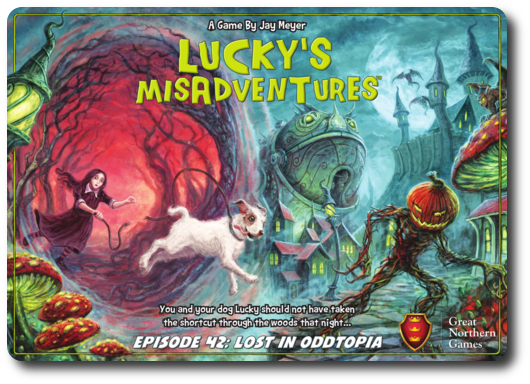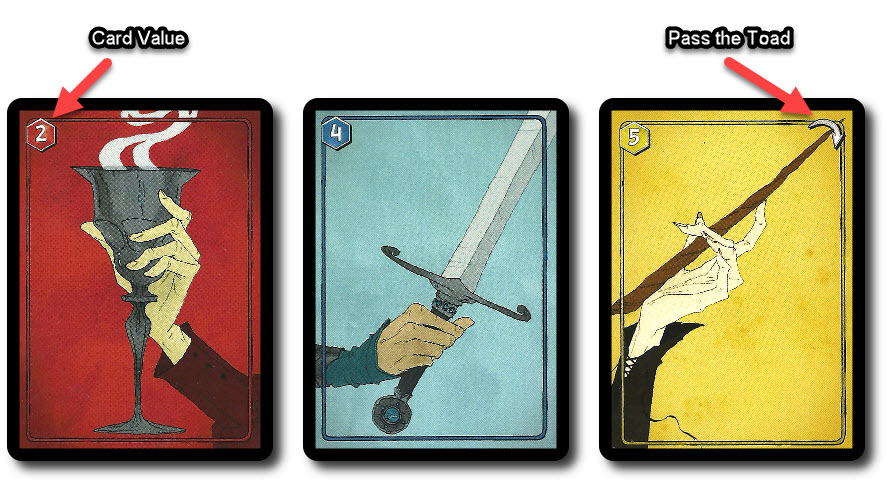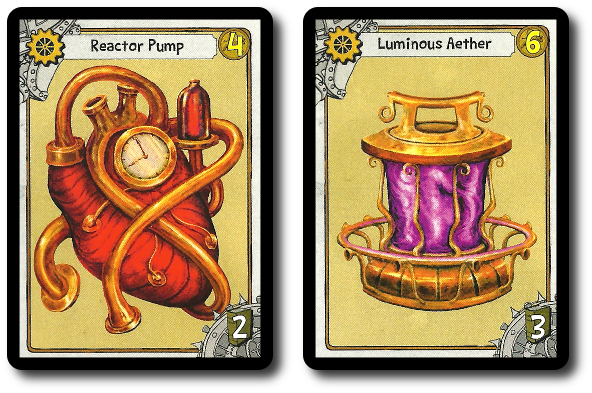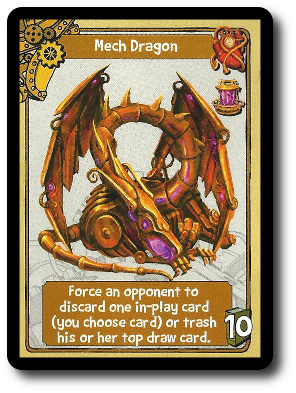Please Take Note: This is a review of the final game, but it might change slightly based on the success of the Kickstarter campaign. The game is being reviewed on the components and the rules provided with the understanding that “what you see is not what you might get” when the game is published. If you like what you read and want to learn more, we encourage you to visit the Kickstarter campaign. Now that we have all that disclaimer junk out of the way, on with the review.

The Basics:
- For ages 10 and up
- For 2 to 4 players
- Approximately 60 minutes to complete
Geek Skills:
- Active Listening & Communication
- Counting & Math
- Logical & Critical Decision Making
- Reading
- Strategy & Tactics
- Risk vs. Reward
- Hand/Resource Management
Learning Curve:
- Child – Moderate
- Adult – Easy
Theme & Narrative:
- Rule the oddities of a strange world or escape them as quickly as possible
Endorsements:
- Gamer Geek approved!
- Parent Geek approved!
- Child Geek approved!
Overview
They say that truth is stranger than fiction. If such is the case, then the origins of some of our strangest tales are the very stuff of nightmares and dreams. For example, let us consider the origins of The Wizard of Oz or Alice in Wonderland and its strange inhabitants. Needless to say, visiting the real Oz or Wonderland would truly be an odd experience. Prepare for a trip to Oddtopia, kids…
Lucky’s Misadventures, designed by Jay Meyer and to be published by Great Northern Games, will reportedly be comprised of 24 Fate cards, 4 Lucky Ally cards, 36 Sidekick Ally cards, 24 Hireling Ally cards, 59 Maven Ally cards, 48 Junk cards, 37 Machine cards, 1 Feed the Toad card, and 2 Machine Matrix/Turn Order placards. As this is a review of a prepublished game, I cannot comment on the game component quality. Artists Michael D. Clark, Abigail Larson, and Peter Wocken provide card illustrations that bring the oddities in the game to visual life, adding to the game’s already strange theme and subtly dark narrative.
Welcome to Oddtopia
Lucky’s Misadventures is a deck-building game. Every card, as a result, has a very specific purpose. Each of the different card types are summarized here.
Fate Cards
The Fate cards change the game by altering what abilities can be used by Ally cards and altering the game rules that impact all the players. There are two specific types of Fate cards. These are Minor Arcana and Major Arcana.
The Minor Arcana cards represent three tarot card suits. Specifically, the “Cups”, “Swords”, and “Wands”. When drawn and put into play, whatever Ally card that has an ability that matches the drawn Minor Arcana suit can be used for that round.

The Major Arcana cards represent major court cards in the tarot deck. Specifically, the “Magician”, the “Tower”, the “Fool”, “Judgement”, “Fortune”, and “Death”. While the Minor Arcana cards impact what abilities can be used per played Ally cards (thus only impacting certain players), the Major Arcana cards impact all the players in the game.

Ally Cards
Ally cards represent the many strange creatures (and your own very special dog) who will help you navigate the twisted world of Oddtopia. Each Ally with the exception of “Lucky” (your faithful companion) has a faction (Tinkerer, Wicked, or Oddling) and a class (Sidekick, Hireling, and Maven).
Factions determine how the card is used. Tinkerers are used to help the player acquire junk that can be used to build machines. Wickeds are used to gain magical powers and summon forth the powerful Mavens. The Oddlings are peaceful and practice the old laws of the Ancients, but are also very useful to purchase goods and services.
Classes determine the overall power of the Ally card. Sidekicks are the weakest, but also the most abundant. You’ll never be without a friend in Oddtopia. Hirelings will aid you, but only if you pay them. Use the economic might of the Oddlings to persuade Hirelings to join your cause. Mavens are the most powerful and can either be bribed or won in a challenge. Mavens provide abilities just like the Hirelings, but due to their powerful influence, can also help the player win the game.

From left to right: Sidekick, Hireling, and Maven
A) Faction and Power Value
B) Buy Points
C) Card Cost
D) Card Action
E) Action Trigger (determined by Fate cards)
F) Victory Points
Lucky is a special Ally card that every player gets at the start of the game. Lucky is the player’s faithful friend throughout their journey and a protector. When in play, Lucky guards the player, making it impossible for an opponent to target them. But even Lucky must bend to the will of Fate.

Junk Cards
Junk cards represent the many strange and wonderful bits and pieces left by the Ancient race that once lived and ruled Oddtopia, but now only their pieces of scrap and broken machines remain. The Tinker faction highly prizes these cards and will use them to help the player build powerful machines.

Machine Cards
While many of the cards in the game can be won or purchased, the Machine cards must be built. Players use Junk cards to recreate ancient constructs, like the Mech Dragon (that requires one Reactor Pump and one Luminous Aether to build). These machines are the powerful relics left behind by the Ancients. If rebuilt, they become very powerful tools against foes and a clear path to victory.

Follow the Yellowed Broken Road
To set up the game, first find the Feed the Toad card, select a player at random, and give the card to them.

Second, each player is now given their personal starting deck. Each starting deck is comprised of 1 Lucky card, 3 Tinman cards, 3 Lion cards, and 3 Scarecrow cards. Each of the cards should have a different Fate value. For example, each player will receive a Scarecrow that is associated with Cups, a Scarecrow associated with Wands, and a Scarecrow associated with Swords. Each player should also select one Hireling card (Winged Monkey, White Rabbit, or the Clockmaker). Each player shuffles their starting deck and places it face down in front of them. This is the player’s draw deck for the duration of the game. Leave room for a personal discard pile.
Third, shuffle the Maven cards and place the deck face-down to create the Maven draw deck. Draw the top five and place them in a row, face-up. This row is referred to as the “Maven Bank”. Feel free to arrange the cards from their lowest value to their highest value to make it easier to quickly scan the bank for cards that can be afforded.
Fourth, shuffle the Hireling cards and place the deck face-down to create the Hireling draw deck. Draw the top-most card and place it next to the draw deck, face-up. This is not a discard pile. Rather, this top-most card represents the Hireling that can be purchased by the players during the game.
Fifth, shuffle the Junk cards and place the deck face-down to create the Junk draw deck. Draw the top four and place them in a row, face-up, next to the draw deck. This row is the “Junk Bank”. Again, feel free to arrange the cards from their lowest value to their highest value to make it easier to quickly scan the bank for cards that can be afforded.
Sixth, shuffle the Fate cards and place the deck face-down to create the Fate draw deck. Draw the top three Fate cards and place them face-down to create the Fate discard pile. Do not look at the Fate cards that were drawn!
Seventh, and finally, designate a free space in the middle of the playing area. This space is reserved for the community discard pile.
That’s it for game set up. Each player now draws five cards from their draw deck to create their hand. The player with the Feed the Toad card is the starting player.
The Good, the Bad, and the Exceedingly Odd
Lucky’s Misadventures is played in rounds for no more than 14 rounds in total. Each round has five phases. Each phase in a single round of game play is summarized here.
Phase One: Feed the Toad!
Legends states that the Great Mechanical Toad was built by the Ancients and does only one thing: keeps the world from being destroyed. In their wisdom (and fear) the inhabitants of Oddtopia gather each day to feed the Great Mechanical Toad magical mushrooms to appease it and hold off Armageddon for another 24 hours. In game terms, the player who currently has the Feed the Toad card discards any Fate cards played during the last round and draws three new Fate cards, revealing them to all the players.
The Feed the Toad card is then immediately handed to the next player in the turn order sequence, going clockwise, for each Fate card that shows the icon that triggers the Feed the Toad card being passed. In this way, the starting player for each round is never certain and always left to the fickleness of Fate. If no such Fate card is drawn, the Feed the Toad card remains in the hands of the player who currently controls it or might return to the player who originally had it.
Phase Two: Play and Reveal
Each player now looks at their hand of five cards and selects three to play, placing them face-down in front of them. All players then reveal their played cards after all the players have placed three cards face-down.
Phase Three: Take Action
Beginning with the player who has the Feed the Toad card, each player now takes any actions that are available to them based on the cards played and the revealed Fate cards. Actions include the following:
- Card Action: resolve the action listed on the played card
- Buy Action: use the purchasing power provided by the card (mostly the Oddlings) to purchase other cards
- Build a Machine Action: trash two in-play (revealed) Junk cards to build a Machine card
- Escape Oddtopia: which will immediately make the player the winner of the game
Phase Four: Challenge
Players now determine who has the most faction strength backing them by counting up the points provided by the player’s played Tinkerer and Wicked cards. The player with the most points provided by their played Tinker faction cards wins the Tinkerer Challenge. This awards the player one free Junk card from the “Junk Bank”. The newly acquired card is placed in the player’s discard pile. The player with the most points provided by their Wicked faction wins the Wicked Challenge. This awards the player one free Maven card from the “Maven Bank”, which is also added to the player’s discard pile.
The margin of victory (major or minor) will determine the overall value of the card they can be selected.
Phase Five: Discard and Draw
Each player must now discard all played cards in front of them into their discard pile and any cards still left in their hand. Then the player draws as many cards as needed from their draw deck until they have five cards in hand.
This ends the round. A new round now begins as noted above.
Half of a Whole
A full game, unless ended early by a player escaping, will only last 14 rounds. After the Fate deck is depleted (seven rounds), it’s recreated. Once the Fate deck is depleted a second time, the game comes to an end.
Ending It All
The game can end one of two different ways. The first is if the Fate deck is depleted for a second time. The second is if a player escapes Oddtopia. A player can leave Oddtopia if the player has the Time Machine and Reactor Pump in play during the round, if the player has all three “Sisters” in play during the round, or if the player has “Pumpkin Ted”, the “Clockmaker”, and the “Fate Clock” in play during the round.
If a player escapes, they automatically win the game. Mostly due to the fact that they have proven to everyone that they are really good at building a deck. If the game ends without anyone leaving (a much more likely scenario, especially if all the players are carefully watching what cards are captured and played), the player with the most victory points (by counting the victory point values on their cards) wins the game.
To learn more about Lucky’s Misadventures, visit the game publisher’s website or the Kickstarter campaign.
Final Word
 The Child Geeks were as interested in the game play as they were its many characters. According to one Child Geek, “This game tells you a story that you want to learn more about. I feel like I’m exploring its world, but only able to read the first chapter.” The more literate of the Child Geeks often pointed out the many ties the game seemed to have to both the Wizard of Oz and Alice in Wonderland, but not once did they think the game was truly either. Another Child Geek said, “I don’t normally like deck-building games, but I like this one because every card can do something, if it is allowed.” The Child Geek alludes to the fact that the most useful card can become partially inert while in play, but it can always provide something of value. When the games were over, those that escaped or remained in Oddtopia all agreed it was a place well worth their time.
The Child Geeks were as interested in the game play as they were its many characters. According to one Child Geek, “This game tells you a story that you want to learn more about. I feel like I’m exploring its world, but only able to read the first chapter.” The more literate of the Child Geeks often pointed out the many ties the game seemed to have to both the Wizard of Oz and Alice in Wonderland, but not once did they think the game was truly either. Another Child Geek said, “I don’t normally like deck-building games, but I like this one because every card can do something, if it is allowed.” The Child Geek alludes to the fact that the most useful card can become partially inert while in play, but it can always provide something of value. When the games were over, those that escaped or remained in Oddtopia all agreed it was a place well worth their time.
 The Parent Geeks also enjoyed the game, finding the game’s theme and narrative to be very interesting and the game play to be engaging. According to one Parent Geek, “An easy enough game to quickly learn – thanks to the many deck-building games I have played – and a lot of neat little new rules that make the game feel unique.” Another Parent Geek said, “The game itself is fun and challenging and the game world you play in is strangely dark and beautiful. I wanted to learn more about those characters I interacted with in the game as much as I wanted to win the game.” Even the casual gamers found Lucky’s Misadventures to be pleasure, after being at first slightly intimidated by the different cards. They quickly learned that the cards themselves were easy to use, but hard to master. All of the Parent Geeks voted to approve this adventurous misadventure.
The Parent Geeks also enjoyed the game, finding the game’s theme and narrative to be very interesting and the game play to be engaging. According to one Parent Geek, “An easy enough game to quickly learn – thanks to the many deck-building games I have played – and a lot of neat little new rules that make the game feel unique.” Another Parent Geek said, “The game itself is fun and challenging and the game world you play in is strangely dark and beautiful. I wanted to learn more about those characters I interacted with in the game as much as I wanted to win the game.” Even the casual gamers found Lucky’s Misadventures to be pleasure, after being at first slightly intimidated by the different cards. They quickly learned that the cards themselves were easy to use, but hard to master. All of the Parent Geeks voted to approve this adventurous misadventure.
 The Gamer Geeks were, of course, skeptical. They have played many, many deck-building games and believe they fall into two categories. Good or Extremely Poor. There is not middle ground, apparently. After playing Lucky’s Misadventures several times they gave it a great deal of thought and then unanimously agreed that the game was “Good”. According to one Gamer Geek, “Solid rules, interesting card twists, and lots of things to think about. I never felt overwhelmed, but I was not once bored, either.” Another Gamer Geek said, “A unique twist on a classic and overly done game type. I found the game’s theme and game play to be both refreshing and creative. My only concern is the lack of cards in the set. After playing it several times, it became obvious to me how to win the game…not that I did every time, but always came close.” And indeed she did, but the true winner was the game itself, that all the Gamer Geeks agreed to endorse.
The Gamer Geeks were, of course, skeptical. They have played many, many deck-building games and believe they fall into two categories. Good or Extremely Poor. There is not middle ground, apparently. After playing Lucky’s Misadventures several times they gave it a great deal of thought and then unanimously agreed that the game was “Good”. According to one Gamer Geek, “Solid rules, interesting card twists, and lots of things to think about. I never felt overwhelmed, but I was not once bored, either.” Another Gamer Geek said, “A unique twist on a classic and overly done game type. I found the game’s theme and game play to be both refreshing and creative. My only concern is the lack of cards in the set. After playing it several times, it became obvious to me how to win the game…not that I did every time, but always came close.” And indeed she did, but the true winner was the game itself, that all the Gamer Geeks agreed to endorse.
 Lucky’s Misadventures does a lot of things right. It puts all of its emphasis on building a deck that actually does something of real value and on multiple levels. If that sounds difficult to create, you are right. Each card is essentially a cog in a machine with intrinsic purpose, but without a set blueprint. Interestingly enough, the simple machine the players build with their deck is surprisingly versatile and highly influenced by random outcomes that will keep even the most experienced deck-builder on the edge of their seat. Not only will a player have to build into their deck specific outcomes, but provide enough diversity to ensure that whatever Fate card is revealed, they always have an outcome worthwhile. This throws a very interesting new twist in an otherwise very old concept. You must build your deck for the knowns and the unknowns in equal measure.
Lucky’s Misadventures does a lot of things right. It puts all of its emphasis on building a deck that actually does something of real value and on multiple levels. If that sounds difficult to create, you are right. Each card is essentially a cog in a machine with intrinsic purpose, but without a set blueprint. Interestingly enough, the simple machine the players build with their deck is surprisingly versatile and highly influenced by random outcomes that will keep even the most experienced deck-builder on the edge of their seat. Not only will a player have to build into their deck specific outcomes, but provide enough diversity to ensure that whatever Fate card is revealed, they always have an outcome worthwhile. This throws a very interesting new twist in an otherwise very old concept. You must build your deck for the knowns and the unknowns in equal measure.
Counting cards is surprisingly helpful in Lucky’s Misadventures. Three Fate cards are randomly drawn and placed face-down so none of the players see what they are. This is exceedingly important, because any elitist gamer worth their weight in meeples is going to immediately realize that being able to guess the outcome of the Fate cards will grant them a very real advantage. Luckily for the non-elitists, this exercise is not at all easy until the sixth and thirteenth rounds of the game. It is, however, an exercise that becomes easier as the game progresses. Players will have no idea what Fate cards are available until they are played. As the game continues, it becomes easier to see where the winds of Fate will possibly blow.
I very much liked this game. It’s set in a wonderfully interesting world I wanted to explore. It also has a moderately easy learning curve that allows players to jump in and learn as they go with more than enough depth and strategy to keep you engaged. There is a good dose of player interaction throughout to keep players awake at the table and enough card interaction to build some wonderfully clever combos. Running down the middle of the game is this constant need to balance possibility with probability. Players can build their deck with purpose, but they are always left a pawn to the randomness of Fate.
Do try Lucky’s Misadventures if the opportunity presents itself. It’s an undertaking well worth venturing.
This is a paid for review of the game’s final prototype. Although our time and focus was financially compensated, our words are our own. We’d need at least 10 million dollars before we started saying what other people wanted. Such is the statuesque and legendary integrity of Father Geek which cannot be bought except by those who own their own private islands and small countries.
Discover more from Father Geek
Subscribe to get the latest posts sent to your email.





